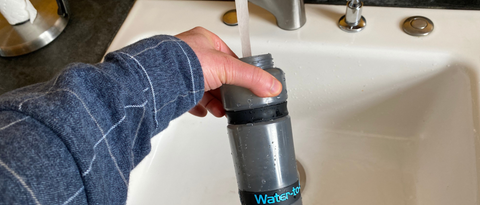Are you concerned about the presence of fluoride in your drinking water? Whether you're a health enthusiast or just someone who wants the purest drinking water possible, we've got you covered. In this guide, we'll dive into the controversial topic of fluoride in water treatment and explore various methods to eliminate it. Say goodbye to the potential health effects of fluoride and hello to crystal clear, healthy drinking water.
Water Filters That Remove Fluoride
Water filters are an effective solution for eliminating fluoride from drinking water, but not all filters are created equal. Different types of water filters have varying levels of effectiveness when it comes to fluoride removal. Here are some of the most popular and effective water filters that can help eliminate fluoride from your drinking water:
- Reverse Osmosis (RO) Filters:
Reverse osmosis filtration systems are known for their ability to remove a wide range of contaminants, including fluoride. These systems use a semipermeable membrane to remove particles, ions and molecules from water, providing clean and safe drinking water. RO filters are highly effective in removing fluoride, making them a popular choice for households that are concerned about fluoride exposure. However, RO filters can be expensive and require a power source.
- Activated Alumina Filters:
Activated alumina filters are specifically designed to remove fluoride from water. These filters contain aluminum oxide, which has a high affinity for fluoride ions. As water passes through the filter, fluoride ions adhere to the surface of the activated alumina, effectively reducing fluoride levels in the water. Activated alumina filters are often used in conjunction with other filtration methods for comprehensive water treatment.
The Water-to-Go filter uses activated alumina and is excellent at removing fluoride from your drinking water. A portable fluoride filter water bottle like Water-to-Go filters out fluoride, chlorine as well as lead, arsenic, microplastics and any microbiological contaminants that may lurk in your drinking water. Since the water you drink at home is likely the same water you drink at school, the gym or at work, a portable water filter bottle ensures you have safe drinking water anywhere you go.

- Distillation Systems:
Distillation is another method commonly used to remove fluoride from water. Distillation systems work by heating water to its boiling point, then collecting the purified steam and condensing it back into liquid form. Since fluoride has a higher boiling point than water, it remains behind in the boiling chamber, resulting in water that is virtually free of fluoride and other contaminants. However, it's important to note that distillation may also remove beneficial minerals from the water. In addition, distillation systems can be an expensive and overly elaborate solution if you just want to get the fluoride out of your tap water at home.
Tips for Choosing the Right Water Filter to Eliminate Fluoride from Your Drinking Water
When choosing how to remove fluoride from your drinking water, consider the following factors:
- Filtration Method: Look for filters that use reverse osmosis, activated alumina, or ion exchange technology as these are effective at removing fluoride.
- Capacity: Consider the capacity of the filter and how often it will need to be replaced.
- Cost: Compare the cost of different filters and consider the long-term costs of replacement filters.

Frequently Asked Questions:
Does Boiling Water Take the Fluoride Out?
Boiling water is often considered a reliable method for water purification as it helps to remove contaminants. However, people often wonder if boiling water can also eliminate fluoride, a potentially harmful substance that is found in drinking water. Unfortunately, the answer is no. Fluoride has a higher boiling point than water, which means that when water is boiled, it evaporates and leaves behind the fluoride ions. Thus, boiling water cannot be relied upon as a method for removing fluoride from drinking water.
Do Refrigerator Filters Remove Fluoride?
It's a common practice to use refrigerator filters to enhance the taste and odor of water by eliminating impurities. However, these filters may not be effective in removing fluoride. Activated carbon is the primary method used in most refrigerator filters to absorb contaminants, but this method does not efficiently capture fluoride ions. Relying solely on a refrigerator filter to eliminate fluoride from water may not be sufficient to safeguard against fluoride exposure.
Do Carbon Filters Remove Fluoride?
Carbon filters, also referred to as activated carbon filters, are widely used to enhance the taste and smell of water by attracting pollutants onto their surface. Although carbon filters are highly effective in eliminating several common water impurities, they are not primarily designed to remove fluoride. While carbon filters may reduce fluoride levels to a certain extent, they are not the most reliable option for eliminating fluoride. Consider activated alumina filters instead.
What is the cheapest way to remove fluoride from water?
The cheapest way to remove fluoride from water is to use activated alumina filtration. Activated alumina filters are relatively inexpensive. A Water-to-Go water filter bottle, which uses activate alumina costs as little as $55.99.

What is the process of removing fluoride from water called?
The process of removing fluoride from water is called defluorination. This process involves using various methods to reduce the fluoride levels in drinking water to safe levels.
Does distilled water remove fluoride?
Distilled water does not remove fluoride. While distillation can remove many impurities from water, it does not effectively remove fluoride.
Can saliva wash away fluoride?
Saliva can help wash away fluoride from the mouth, but it does not remove fluoride from the body.
What are the side effects of fluoride in drinking water?
According to the National Institutes of Health (NIH), excess amounts of fluoride ions in drinking water can cause dental fluorosis, skeletal fluorosis, arthritis, bone damage, osteoporosis, muscular damage, fatigue, and joint-related problems.
Why is there fluoride in water? Fluoride is often added to drinking water supplies to prevent tooth decay and improve dental health. However, natural sources of fluoride can also contribute to fluoride levels in water.
Conclusion
It is important to be mindful of the amount of fluoride in our drinking water as it can have both positive and negative effects on our health. By taking steps such as testing the fluoride levels and using a water filtration system that specifically removes fluoride, we can enjoy the benefits of clean safe drinking water while minimizing the risks associated with excessive fluoride exposure. Let's prioritize our health and make informed decisions about our drinking water.
Additional sources of information about the impact of fluoride in water and effective ways to remove it:
- The Centers for Disease Control and Prevention (CDC): The CDC provides information and resources on water fluoridation, including its benefits and potential health risks. They also offer guidance on testing fluoride levels in drinking water and ways to reduce fluoride exposure.
- The World Health Organization (WHO): The WHO has published reports and guidelines on fluoride in drinking water, including its effects on health and recommendations for monitoring and controlling fluoride levels. They provide valuable insights into international standards and practices related to fluoride in water.
We in Britain have our own National Health Service. Who are the World Health Organisation, and who gave them the right to interfere in English heath matters?
AT THE VERY BEGINNING OF THIS ARTICLE YOU SAY THIS:
Distillation Systems:
Distillation is another method commonly used to remove fluoride from water. Distillation systems work by heating water to its boiling point, then collecting the purified steam and condensing it back into liquid form. Since fluoride has a higher boiling point than water, it remains behind in the boiling chamber, resulting in water that is virtually free of fluoride and other contaminants. However, it’s important to note that distillation may also remove beneficial minerals from the water. In addition, distillation systems can be an expensive and overly elaborate solution if you just want to get the fluoride out of your tap water at home.
AND THEN YOU END YOUR ARTICLE WITH THIS: Which is it, I’m confused. ( The first statement appears to be the most accurate)
Does distilled water remove fluoride?
Distilled water does not remove fluoride. While distillation can remove many impurities from water, it does not effectively remove fluoride.


Comments